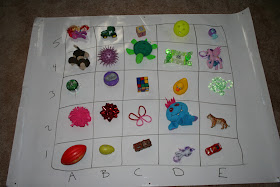Over the last couple months I have been slowly introducing graphs into our play time. I am really surprised by how much fun my daughter has had while learning different ways to graph. Here are some examples of how we have made graphs fun.
Venn Diagram
She picked out a bunch of things to take in the bath with her one day. We recorded whether the objects stayed afloat, sank, or did both (depending on if we filled them with water or not). After she got out of the bath we set down and discussed how a venn diagrams works. She helped me list all of the items that stayed afloat in the first circle, all the ones that sank in the second circle, and all the ones that did both where the circles connect.
We also did a hands-on version of this venn diagram. I made two big overlapping circles on the floor and I let her place the objects where they belonged. This would be a great way to introduce venn diagrams to kids that are really hands-on and do not enjoy "paper and pen" learning activities.
Bar Graph
My daughter and I grabbed a collection of different items from around the house. We grouped them together so that we could easily count all of one type of object.
I prepared the bar graph and explained how it works. We counted the first two objects together and I showed her how to fill in the graph. Then she did the rest with only a little help.
She really enjoyed counting her favorite toys and graphing how many she had. She also really liked that I added in some fun snacks that she could eat after graphing them.
Coordinate Graph
This is not something that I had planned on teaching her early on but she has a Leapster Game that uses coordinate graphing in one of the games. She kept getting frustrated because she could not understand it. So I decided that I should find an easier way to teach her so the game would be more enjoyable.
I used our dry erase graph sheet to make two different graphs. In one I used the "name" of the square to help her learn how the naming works. I told her to find A1 and then helped her find the 1 on the side of the graph and the A at the bottom. I showed her that when you find where those two lines cross that square is called A1. As we found the squares I called out, she colored them in.
In the second graph, I used pictures in the squares instead of the "name", that way she really had to learn how to follow the lines to the right square instead of cheating by just reading the name in each square. As we found the squares she circled them.
She seemed to understand the concept of following the lines but it was just too difficult for her right now. When I could see she was starting to get upset that she wasn't able to do it on her own I came up with a new way to play.
I made a large graph on the back of our map and put it on the floor. I placed a toy in each square. She stood on the edge of the graph with two yard sticks and I called out B3. She had to find the B column and lay her stick across the whole column. Then she had to find row 3 and lay her stick across that whole row. She then found where the sticks touched each other (over the B3 square) and she got to pick up that toy. This game was really fun for her and she asked to play it a few times in a row. By the end I could see that she was understanding the concept and the sticks were giving her the confidence that she was finding the right square. Now when we do the "paper and pen" version of this graph I give her two pipe cleaners to use to help follow the rows to the correct square.
This has been the hardest graphing concept for her to learn by far but she is picking it up without frustration because we are working together and making it into a game.






No comments:
Post a Comment